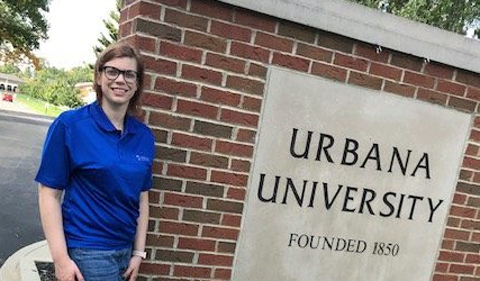Katie L. Brown is currently Lead Faculty in History at Urbana University, a position she started in August.
A Contemporary History Institute student, Brown completed her M.A. degree at Ohio University in 2011 under the direction of Dr. John Brobst, Associate Professor of History. She then began her Ph.D. studies at the University of Akron, where she is now preparing to defend her dissertation, “The End of Gentlemanly Warfare? Gendered Language and Great Britain’s Evolving Arguments for Strategic Bombing, 1920-1945,” under adviser Dr. Martin Wainwright.
CHI recently spoke with Brown about her career since leaving Ohio University and her current teaching and research activities.
What classes have you taught over the last few years and what are you teaching at the moment at Urbana?
Currently I am teaching the first half of World Civilization survey, from prehistory-1500; the first half of the U.S. History survey, from 1492-1865; Twentieth Century Europe; and U.S. Social and Cultural History. As an adjunct, I taught Western Civilization since 1500; American History after the Civil War, and was a discussion leader for Humanities in the World since 1300. For the past two summers I have also participated in AP grading for European History.
Your research focuses on early 20th-century British air power and doctrine. Can you explain where you fit into the historiography? What sort of source material did you rely on?
My work brings a gendered aspect to traditional military/political history. I use a gendered lens to examine Royal Air Force polices on strategic bombing, as well as government debates on the topic, to explore the British justifications behind the change in strategy from 1920-1945. My work fits in the emerging field of war and society, and with such works as Susan R. Grayzel’s At Home and Under Fire: Air Raids and Culture in Britain from the Great War to the Blitz and Brett Holman’s The Next Air War in the Air: Britain’s Fear of the Bomber, 1908-1941.
I am basing the framework of my dissertation on the ideas of the socially-constructed dual spheres – both the masculine and feminine and the militaristic male and the pacifistic female. Therefore, I am using theoretical frameworks established by Lenore Davidoff, Catherine Hall, Jean Bethke Elshtain, and Margaret Higonnet to examine the words these politicians, military officials, and contemporary commentators are using in their arguments for or against strategic bombing.
A lot of my sources came from the Arthur Harris Papers found at the RAF Museum archives and from the General Records of the Air Ministry at the British National Archives. I also rely on parliamentary debates from the time period and contemporary writings on the Strategic Bombing debate. One chapter of my dissertation is going to look at the language that the 1930s pacifist movement used to argue against war in general, and strategic bombing specifically. Therefore I am also looking at the writings of Vera Brittain and other pacifists of the time period.
I would like to incorporate some of the “bottom-up” sources to see how these policy changes affected and were interpreted by the average Briton, so I have collected some war memoirs from the Imperial War Museum and Mass Observation Online. Due to time and space constraints, they might have to be set aside for a future project, however.
How did your time as a student in CHI inform the research questions for your thesis as well as subsequent doctoral dissertation?
The one CHI course that particularly influenced my research for my thesis and dissertation was a course that examined the interplay of war, empire, and power politics, taught by Dr. Brobst in the Spring Quarter of 2010. Many of the works Dr. Brobst chose for us to analyze dealt with the development of strategy throughout the 19th and 20th centuries. Thus, they inspired me to delve deeper into why the British relied so heavily on strategic bombing, even after it failed to deliver the “knock-out blow.”
Has the Contemporary History Institute’s multidisciplinary approach influenced your teaching?
Yes; I am a firm believer in an interdisciplinary approach to the study of history. I like to remind my students that history is not as cut and dry as they may have been taught in high school. I like to show them that there is more than one way to look at their primary sources, and that they can think outside the box when choosing their sources to begin with. I also like to incorporate art and poetry into my lectures. For example, when discussing the First World War, I like to have a discussion incorporating the War Poets and how their writings can be used to interpret the disillusionment felt during that time period. I also like to show Picasso’s Guernica and have my students interpret what Picasso was arguing.




















Comments